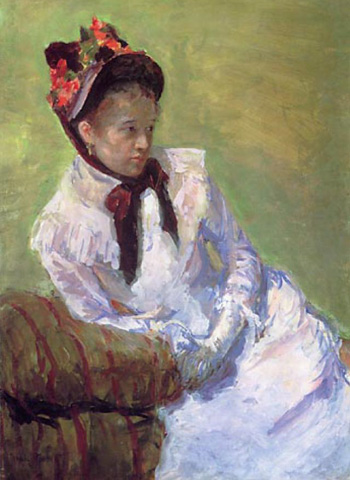Painters use to mix pigments in their studios. Tube paints provide the freedom to paint out-of-doors. This no fuss no muss ability is revolutionary to the world of painting. It is the catalyst announcing Modern Art, and the passing of the Renaissance era. A distinctive style and a new technique of painting is born. Beginning with Monet, successive paintings in this collection illustrate change and the differences between Modern and Renaissance painters. The London based Winsor-Newton Company invented and manufacture tube paints. This image is of their first tube paints, 1840 - 1911.
Mary Cassatt (1844 –1926) is born into an upper-middle class family in a Pittsburgh, PA suburb. Early tutoring in art leads to a few years of studying painting, at the Pennsylvania Academy of Fine Arts, in Philadelphia. Miss Cassatt tires of patronizing instructors, their slow pace, and fellow male students.
Childhood years in Paris evoke sweet memories so continuing her education there chaperoned by her mother makes sense. While École des Beaux-Arts in Paris does not accept women, Mary studies independently, with influential artists, in different parts of Europe.
In a few years, the budding young artist is finally accepted into the Paris Salon. To be juried into an exhibition connected to the school is an accomplishment; Cassatt settles in Paris.
The artist Edgar Degas invites Mary to show her paintings with the Impressionists. The 1890s is Cassatt’s busiest and most creative time.
France awards Mary Cassatt the Legion of Honor for her contribution to the arts and her native country pays homage to the artist with four memorial exhibits of her work.

Modern, French Impressionist movement (c.1880 – 1925) After Napoleon III and the war of 1870, French people are split between old-fashioned royal rulership and a democratic socialist style of government. Despite these differences, France makes “modern age progress” through 1900.
From 1894 – 1906 unwarranted scandals erupt. France’s fundamental differences persist after the democratic, socialists’ side wins. Sad to say bad feelings continue to ruffle feathers into 1914 and WWI.
All the while no proper woman in the 19th century - not even an American in Paris - can casually stroll Paris streets alone looking for subject matter to paint.
Rather than encroach upon the domain of her male colleagues, Miss Cassatt’s decision to pursue painting the prim social pursuits of upper-class women and their moments with their children is a stroke of genius.
The classic Louis XVI furniture and the rug shown in this library continue to influence home furnishings.

Go on to Describe, Analyze, Interpret & Conclude. Contact me for help.
The Child’s Bath 1893. Oil on canvas. 39 x 26 in. (100 x 66 cm.) Mary Cassatt is synonymous with her paintings of mothers and their children.
Very few of Cassatt’s mother and child paintings actually show related people. The artist prefers to select models and match physical types to achieve her desired results.
An exhibit of Japanese prints at the École des Beaux-Arts Academy is supposed to be inspiration for this work. Notice how Cassatt uses the technique of Aerial perspective to highlight the pair from above. The light washes over them onto the block patterns of the rug.
This is an example of a Japanese wood-block print from a bird’s-eye view dating back centuries - courtesy of the Metropolitan Museum of Art in their Heilbrunn Timeline of Art History.
Some scholars say consciously or unconsciously that Cassatt is reworking the Madonna and Child theme. Others describe it as natural and unsentimental. Perhaps this work contains all of these characteristics or it is simply a beautiful setting containing a charming image?